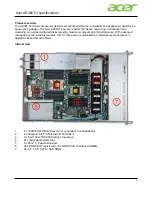
System diagnostic controls
Menu
Description
Configurat ion
Displays the configuration and status information of all detected devices.
Results
Displays the results of all tests that are run.
System health
Provides the current overview of the system performance.
Event log
Displays a time-stamped log of the results of all tests run on the system. This is displayed if at least one event
description is recorded.
System diagnostics
169






































